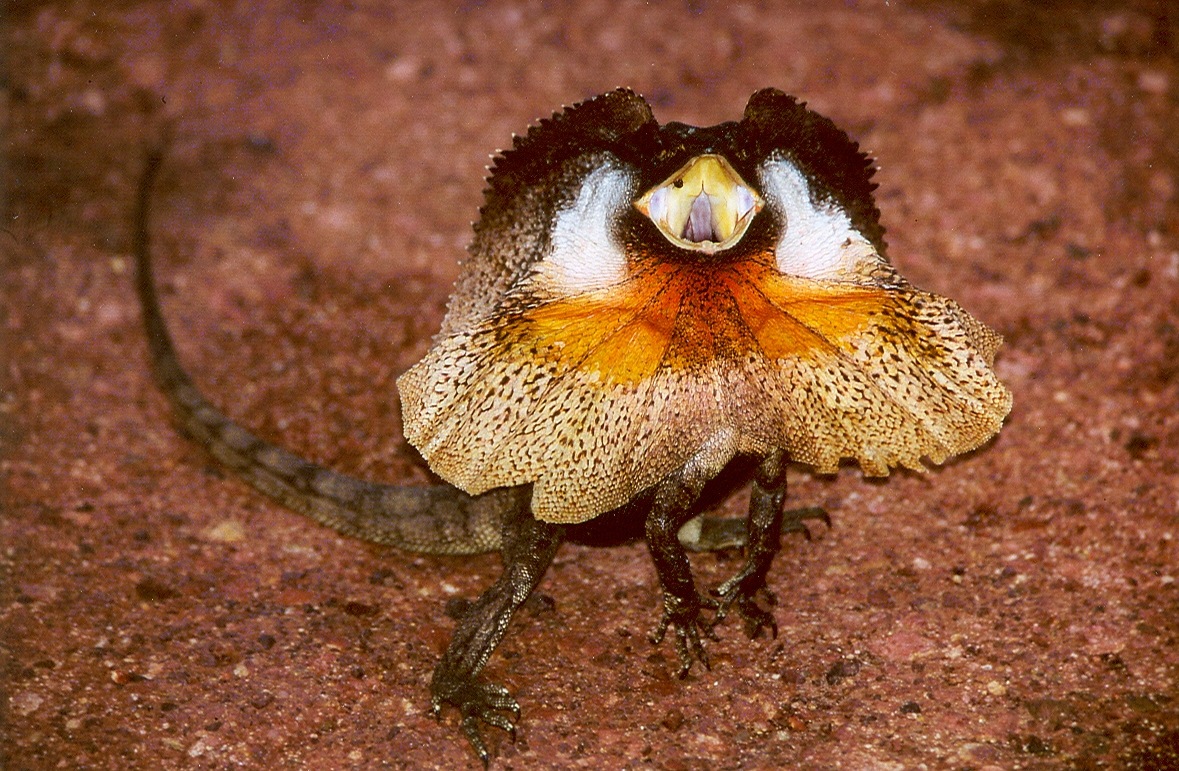neck frill on:
[Wikipedia]
[Google]
[Amazon]

 A neck frill is the relatively extensive margin seen on the back of the heads of
A neck frill is the relatively extensive margin seen on the back of the heads of

 A neck frill is the relatively extensive margin seen on the back of the heads of
A neck frill is the relatively extensive margin seen on the back of the heads of reptile
Reptiles, as commonly defined, are a group of tetrapods with an ectothermic metabolism and Amniotic egg, amniotic development. Living traditional reptiles comprise four Order (biology), orders: Testudines, Crocodilia, Squamata, and Rhynchocepha ...
s with either a bony support such as those present on the skull
The skull, or cranium, is typically a bony enclosure around the brain of a vertebrate. In some fish, and amphibians, the skull is of cartilage. The skull is at the head end of the vertebrate.
In the human, the skull comprises two prominent ...
s of dinosaur
Dinosaurs are a diverse group of reptiles of the clade Dinosauria. They first appeared during the Triassic Geological period, period, between 243 and 233.23 million years ago (mya), although the exact origin and timing of the #Evolutio ...
s of the suborder Marginocephalia or a cartilaginous one as in the frill-necked lizard.
In technical terms, the bone-supported frill is composed of an enlarged parietal bone
The parietal bones ( ) are two bones in the skull which, when joined at a fibrous joint known as a cranial suture, form the sides and roof of the neurocranium. In humans, each bone is roughly quadrilateral in form, and has two surfaces, four bord ...
flanked by elongated squamosals and sometimes ringed by epoccipitals, bony knobs that gave the margin a jagged appearance. In the early 1900s, the parietal bone was known among paleontologist
Paleontology, also spelled as palaeontology or palæontology, is the scientific study of the life of the past, mainly but not exclusively through the study of fossils. Paleontologists use fossils as a means to classify organisms, measure geolo ...
s as the dermosupraoccipital. The feature is now referred to as the parietosquamosal frill. In some genera
Genus (; : genera ) is a taxonomic rank above species and below family as used in the biological classification of living and fossil organisms as well as viruses. In binomial nomenclature, the genus name forms the first part of the binomial s ...
, such as ''Triceratops
''Triceratops'' ( ; ) is a genus of Chasmosaurinae, chasmosaurine Ceratopsia, ceratopsian dinosaur that lived during the late Maastrichtian age of the Late Cretaceous Period (geology), period, about 68 to 66 million years ago on the island ...
'', '' Pentaceratops'', '' Centrosaurus'' and '' Torosaurus'', this extension is very large. Despite the neck frill predominantly being made of hard bone, some neck frills are made of skin, as is the case with the frill-necked lizard of today that resides in Australia
Australia, officially the Commonwealth of Australia, is a country comprising mainland Australia, the mainland of the Australia (continent), Australian continent, the island of Tasmania and list of islands of Australia, numerous smaller isl ...
. The use of the neck frill in dinosaurs is uncertain; it may have been used for thermoregulation
Thermoregulation is the ability of an organism to keep its body temperature within certain boundaries, even when the surrounding temperature is very different. A thermoconforming organism, by contrast, simply adopts the surrounding temperature ...
or simply as a defense mechanism. Indeed, during battles for territory, competing ''Triceratops'' crashed heads together with their elongated horns and the neck frill may have been employed as a kind of shield, protecting the rest of the animal from harm.
Usage of the neck frill in modern reptiles is better documented. Two chief and disparate examples are the horned lizards (genus ''Phrynosoma'') with a bony frill, and the frill-necked lizard (genus ''Chlamydosaurus'') with a cartilaginous frill. The frill-necked lizard's frill is mainly made up of flaps of skin, which are usually coloured pink, supported by cartilaginous spines. Frill-necked lizards puff out these neck frills on either side of its head when threatened. The lizards often raise their frills when battling for territory or when coming into contact with another lizard, especially during mating season. Acoustic measurements from the frill-necked lizard suggest that the frill does not affect binaural hearing for localization but may increase gain for sounds from directly in front of the lizard.
Numerous other animals of both modern and prehistoric times use both skin or bone protrusions to make themselves seem more threatening, attract mates or to thermoregulate. Examples of these are the usage of dewlaps and crests in lizards, dinosaurs and birds. The unusual red-fan parrot has a feathery neck frill which is used for display purposes.
See also
* Armour (zoology) * Crest * DewlapReferences
*Weldon Owen Pty Ltd. (1993). ''Encyclopedia of animals - Mammals, Birds, Reptiles, Amphibians.'' Reader's Digest Association, Inc. . Reptile anatomy Dinosaur anatomy {{Vertebrate anatomy-stub